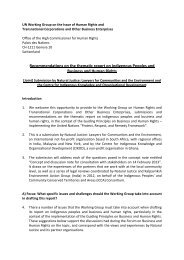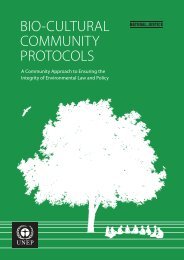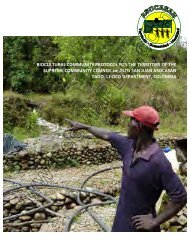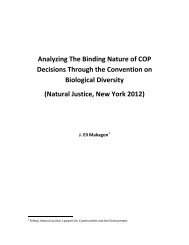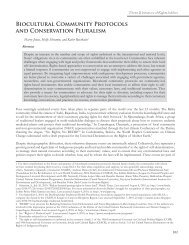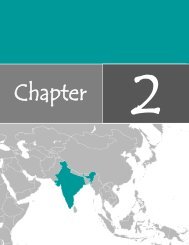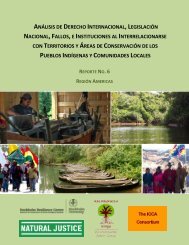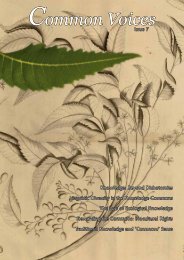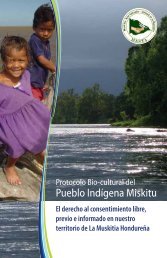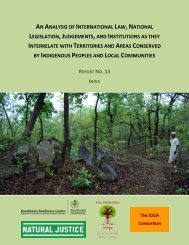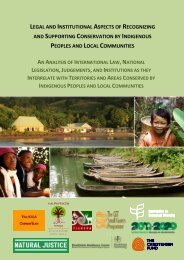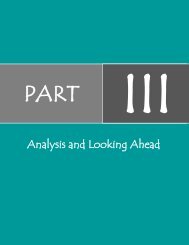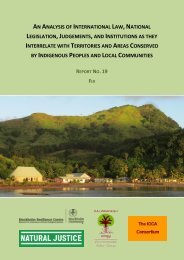Copy of bcp 18112011 English - Natural Justice
Copy of bcp 18112011 English - Natural Justice
Copy of bcp 18112011 English - Natural Justice
You also want an ePaper? Increase the reach of your titles
YUMPU automatically turns print PDFs into web optimized ePapers that Google loves.
The biocultural community protocol <strong>of</strong> maldharis <strong>of</strong> banni10. OUR RIGHTS UNDER INDIAN LAWS AND POLICIES:18A. The Scheduled Tribes and Other Traditional Forest Dwellers (Recognition <strong>of</strong> Forest Rights)Act 2006 and the Scheduled Tribes and Other Traditional Forest Dwellers (Recognition <strong>of</strong>Forest Rights) Rules 2008 (hereafter referred to as the Forest Rights Act and Rules)Maldharis have preexisting pasturage rights to Banni that directly result from thebequeathing <strong>of</strong> this land to us by the erstwhile Maharao <strong>of</strong> Kachchh. Even if these preexistingrights have not been recorded when Banni grasslands were declared a protectedforest in 1955 under the Indian Forest Act <strong>of</strong> 1927, the Forest Rights Act and Rulesrecognize the rights <strong>of</strong> pastoralists to forestland. The Forest Rights Act provides Maldhariswith the opportunity <strong>of</strong> getting previously unrecorded rights recognized through theprocess set out in the Forest Rights Rules.The right <strong>of</strong> Maldhari community as a whole to use Banni and to safeguard it is recognizedunder the Forest Rights Act. The Act grants us the right to use the forest and bestows on usthe duty to conserve and care for it. The Forest Rights Act applies not only to forestdwelling Scheduled Tribes but also other 'traditional forest dwellers' who are dependenton the forest to meet their basic needs. Maldharis fall under the category <strong>of</strong> other'traditional forest dwellers' and as per the Act we can establish that we have resided inand been dependent on Banni for the last 75 years prior to 13-12-2005.The Act introduces the concept <strong>of</strong> 'community forest resources' and 'community forestrights' . The Act in Section 2(a) defines 'community forest resources' to mean 'customarycommon forest land within the traditional or customary boundaries <strong>of</strong> the village orseasonal use <strong>of</strong> landscape in the case <strong>of</strong> pastoral communities, including reserved forests,protected forests and protected areas such as Sanctuaries and National Parks to whichthe community had traditional access'. Rule 31 (3) <strong>of</strong> the Forest Rights Rules provides thatevidence <strong>of</strong> traditional access rights can be established by showing: community rightssuch as Nistar by whatever name called, traditional grazing grounds, sources <strong>of</strong> water forlivestock use, water conservation structures, sacred trees, groves, ponds, burial groundsetc.The Forest Rights Act under Chapter II provides 13 classes <strong>of</strong> forest rights forcommunities. Of these 13 classes <strong>of</strong> rights, the Maldharis claim the following:See generally 'Legal Opinion on Pastoral Tenure Rights- In Banni region <strong>of</strong> Kutch, Gujarat',by Adv. Sanjay Upadhyay, available with Sahjeevan, Bhuj, Gujarat1. Other community rights <strong>of</strong> uses or entitlements such as fish and other products<strong>of</strong> water bodies,grazing (both settled or transhumant), honey, Gum, Charcoal,and traditional seasonal resource access <strong>of</strong> nomadic or pastoralist communities;2. Community rights such as nistar, by whatever name called, including those usedin erstwhile Princely States, Zamindari or such intermediary regimes;



